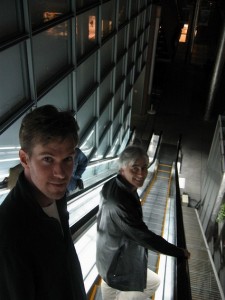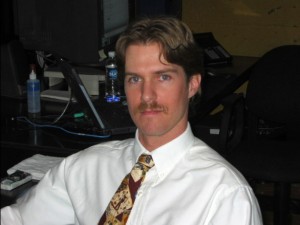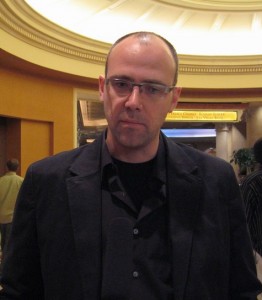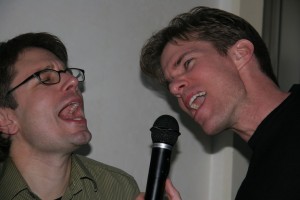Over the last several weeks, there have been some high-profile layoffs in Montreal at Autodesk’s Media & Entertainment Division. For most flame artists, the most recognizable departure would be the “mayor of discreet”, Martin Helie. We cover those changes and interview Autodesk’s Marc Petit about the reasons behind the reorganization.

It’s always hard when companies make major changes… in the case of the latest news out of Autodesk a user might be left wondering who to call… and who are we going to see at NAB.
While less than 10% of the approximately 350 employees in Montreal were laid off, what is striking about the recent changes is that the layoffs included some longtime employees of discreet/Autodesk. These aren’t low-level or mid-level employees, but instead key management indivduals with a high customer profile and a great deal of customer contact. The list includes:
Pierre Bouchard, head of R&D
Martin Helie, Product Specialist
Bill Roberts, head of Product Management
Remy St. Martin, head of Support
Bob Keske, Infrastructure
Most long time user group attendees will know Bill Roberts, Pierre Bouchard and Martin Helie. These three have been the user group face of discreet and had constant user interaction throught the year. Helie is the self-appointed “mayor of discreet” whose humorous usergroup presentations always lightened the event, especially as it became more formalized over the years.
We spoke with Autodesk’s Marc Petit about the reasons for the changes (see below), but wanted to take a moment to thank our friends who are no longer working at Autodesk in Montreal and wish them luck. They are talented individuals and we’re confident they will land on their feet. Over the years, flame and smoke artists have had a great relationship with the developers and marketing crew in Montreal, and we feel this is one of the big reasons for the company’s success in the long term.

Martin Helie was the face of flame as it grew over the years and his knowledge of the product is unsurpassed. Helie is a longtime friend of the fxguide crew as well as flame artists around the world. He helped make the flame product approachable to artists at a time when artists felt anything but welcomed by the stuffy and arrogant Quantel. This focus on the user and listening to the community helped build the product in the eyes of artists — and helped make vfx fun.
Artist Maribeth Emigh, who started on flame as customer number 3, says “Martin Helie embodied the face and heart of flame to me…for the user he was the “man behind the machine†that understood what you actually needed versus what looked cool as a selling feature.” According to Emigh, Helie “was able to bridge the gap between the user and the creator as well as add insight and ideas for both. Hearing that he is no longer part of flame I feel that a final milestone has passed…”

Mike Seymour and I had the good fortune of first working with Pierre Bouchard on the early versions of Fire (1.0) and seeing him rise through the ranks to lead R&D. Generally, the head of R&D in Montreal has been a revolving door of great talent, from Mike Hughes to David Jones, and Bouchard filled that role nicely. He was always open to listening to clients — from the business managers to engineers to artists.
While Bill Roberts could spin a marketing catch phrase like the Music Man’s Harold Hill, he was always open, helpful, and accessible to us here at fxguide through the years. That’s not an easy thing to do, as most contacts in the press field wouldn’t know the modular keyer from the master keyer. Its not often he’d have to deal with technical questions from artists who knew the real story. But when discreet had their hands full with their Y2K 4 bug, he turned to fxguide to help spread the word around the world.

Inteview with Marc Petit, Marc Petit, Autodesk’s Media & Entertainment Vice President
fxg: Can you explain the changes that have happened over the last 10 days or so?
Marc Petit: The breadth of the idea is we felt the need to change the structure for two reasons…one because you know the business model is evolving rapidly because of the PC transition. And you know there were a lot of things that were complex that are a lot less complex to handle, so we wanted to benefit from that. And also we wanted to be a lot more product focused as we reckon it is a very competitive market out there.
So we wanted to move from a functionally orientated organization to more of a product-focused organization, so that’s what’s led us over the past couple of weeks to change the structure. We were heavily function oriented, so some of the functionally oriented positions got eliminated. Unfortunately we lost some very good people in the process.
We feel it was the right thing to do and will re-energize the products and that’s really what it is. At the scale of the division….we’re a 650 person division…that’s not a change of a huge magnitutde…that’s what we needed to do to keep the structure healthy and to move fast as well as get our financials where they need to be.
fxg: Can you speak off about who was let go?
Marc Petit: No…because its not about the people. The people who left deserve a lot of praise that they contributed a lot to our company. But in all fairness for the people who stay and step up…..you know when you reshuffle an organization (the people left) need to feel good that they’ll achieve the results….
fxg: The people who were let go were very high profile people, with a lot of experience and knoweldge, who had a lot of contact with customers. What are you doing to reassure your customers that you are commited to the systems products and making sure their needs are met?
Marc Petit: Some people who were highly visible have left the organization. I think our customers in interacting with us will see a continuity of talent of service and of knowledge so we don’t expect this to be a problem.
[Autodesk is also proactively informing customers so customers who were dealing directly with people who have left have new contacts]
fxg: How are things going to be structured internally?
Marc Petit: I don’t know how much of that is public…we have not even announced it to the team. We come from a place where were very functionally oriented with all the overhead it was creating. We had QA, development, and project management all reporting to different directors. And with the scale of the group it had become somewhat difficult to manage. So moving forward you can expect more product focus…and a lot of cross functionality that we rebuild smaller and more nimble teams that can react faster.
You know how competitive the market is out there…..compositing, color grading, finishing….these are extremely competitive markets. And so where we are with our product line and the maturity of our offering we believe that to better respond to the customer’s requirements and the competitive nature of the market we needed such changes. And we need to push down responsibility and automony to the level of the product instead of hiding with a management layer.
fxg: ….so the basic idea is to have people working on the product and less structure and overhead….
Marc Petit: Exactly. You can create complexity very quickly. You know…you always engineer (when developing a product) to solve one problem. Two years ago we were engineering to solve the problem which was the complexity of our product line and the transition from sgi to the PC. So we had the most complexity because we had to deal with the old sgi gear as well as the new PC gear. Now today we are engineering towards a different problem which is feature competitivity, our ability to react, workflow solutions…and the hardware component is a lot less of an issue today than two years ago.
fxg: Most of the changes impact the systems division, if I’m corrrect?
Marc Petit: They impact exclusively the systems.
fxg: So I guess the question is how viable are the systems products in today’s market? Do the changes have to do with the tough market out there….are your customers requesting systems still or do you see a move toward software-based solutions.
Marc Petit: I’ll let the numbers speak for themselves…and this is public information. In Q3 we had one of our biggest quarters ever for our systems product line. And that to me means that customers when they see our offering on PCs are willing to I would say reconnect…because a lot of them have considered alternative software…’should i have a bunch of desktops. how do I do those things’. And we’re seeing a lot of our customers kind of renewing their vows with Autodesk and recommiting to the systems. They fully understand the value of those systems, especially on the PC platform.
Now of course, the software question is in our mind. Right now what we hear from our customers is that nobody wants to manage versions of a Linux driver. They want a system that’s operational 24×7. They want a single point of contact. And they are happy even on the PC to get that from us. If the hardware evolves at the speed at which we think we might well reach a point down the line which is…maybe in a couple of years maybe in many years…I don’t know how many….I don’t have a crystal ball. But you can imagine that will change at some point and we’ll change and adjust exactly like we do today. So right now we see a big apetite for our systems and we also feel that on the PC its a lot more competitive. By focusing a lot more resources on the product themselves we can compete better and better service our customers.
fxg: So based upon what you’re saying about the systems market, we probably won’t be seeing a software only flame at NAB this year….
Marc Petit: Uhh….first we would never say that and that’s not the way we think about it. (laughs)
fxg: There is a rumor going around that the systems products division is up for sale…could you comment on that.
Marc Petit: First off, I’ve been at discreet/Autodesk for 4 years and i’ve been hearing that pretty much all the time. So there is no comment on that…its just one of those things that comes back every two or three months. Carl Bass I believe has that question almost every earnings call.
fxg: A Piper Jeffries analyst said today that he sees a “steady migration of customers from two-dimensional to three-dimensional software”. Is this related to whats happing in Media & Entertainment or the other Autodesk products?
Marc Petit: That’s other products. Autodesk is almost a 2 billion dollar company growing like a startup and the fundamental reason is because they are converting their 2D drafting user in the CAD space to being 3D modeling users. So they are going from AutoCAD to Revit in the architectural space….so 2D and 3D here mean drafting vs. modeling.
AUTODESK STATEMENT FOR MEDIA
On December 11, 2006, Autodesk, Inc. made proactive changes to its Media & Entertainment systems business in order to optimize that business’ performance and long-term growth. Autodesk Media & Entertainment Vice Presidents Marc Petit and Stig Gruman led the effort. These executives have been with the company for 4 and 7 years respectively.
There has been a reduction in force of less than 10% in Autodesk’s Media & Entertainment systems business. The changes did not impact Autodesk’s Media & Entertainment sales organization or 3D software business.
The systems business, which continues to be led by Stig Gruman, has adopted a more product-focused structure that allows for research and development to take place in smaller, cross-functional teams. These proactive changes are expected to improve systems product roadmaps, while delivering greater operational efficiency.
Autodesk remains focused on delivering best-in-class 2D and 3D software and services for the Media and Entertainment industry, as well as for the Manufacturing, Building and Infrastructure industries.
